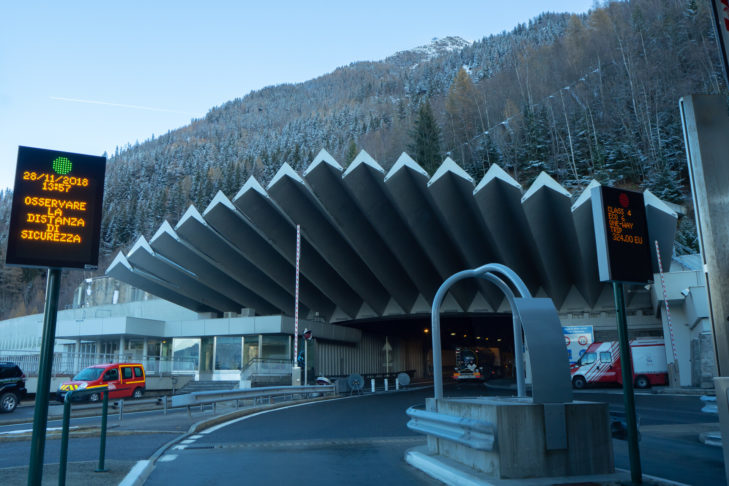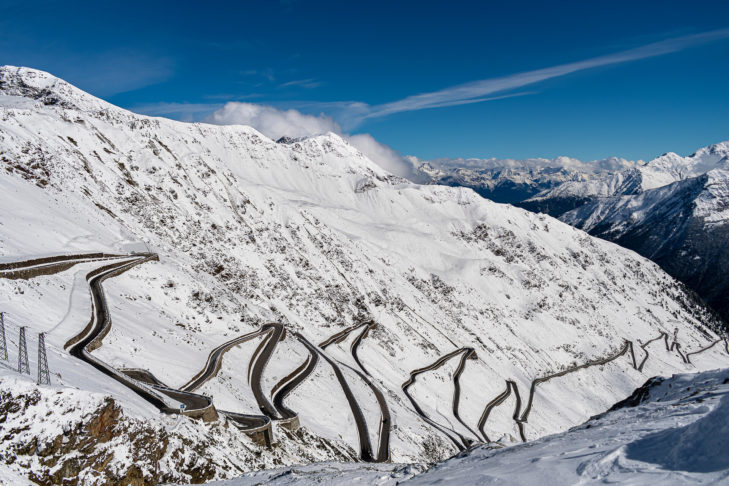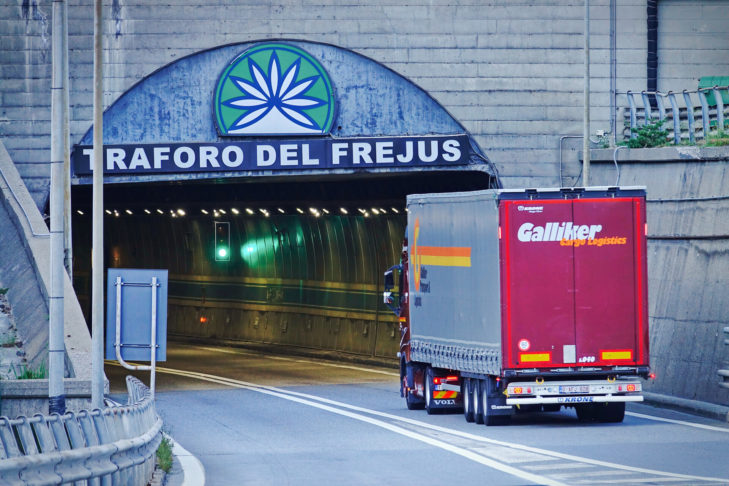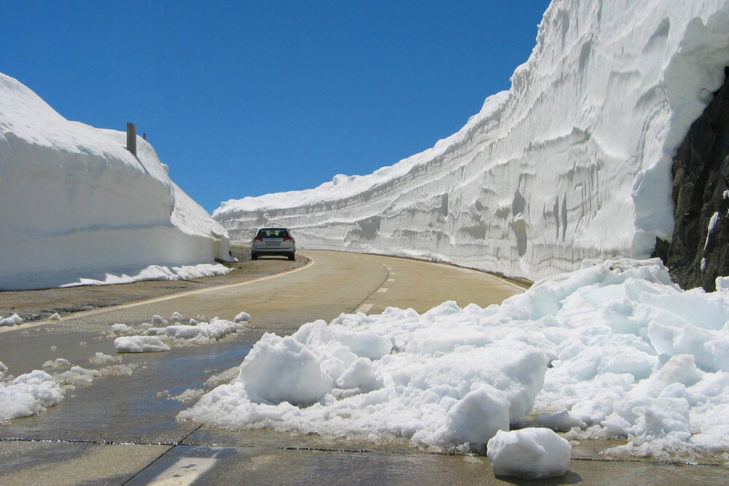Most winter holidaymakers still plan to travel to the ski resort by car. However, crossing the Alps often raises questions about toll costs: Will I have to pay tolls on my way to a ski holiday in 2025? And if so, can I sort it out in advance to avoid stress during the journey? SnowTrex knows the ins and outs of toll fees and explains where winter sports enthusiasts need to pay—whether on the motorway, mountain passes, or before entering Alpine tunnels.
How much do motorway tolls cost drivers in Europe?
| Country | Motorway toll | Costs |
|---|---|---|
| Austria | Yes | 11.50 Euros (£10) (10-day vignette for cars) |
| Italy | Yes | 0.07 Euros (6 pence) (per kilometre by car) |
| France | In some cases | 0.09 Euros (8 pence) (per kilometre by car) |
| Switzerland | Yes | 44.00 Euros (£38.27) (annual vignette) |
| Germany | No | 15.10 to 51.60 cents (13.13 to 44.88 pence) (per kilometre for trucks over 3.5 t) |
| Czech Republic | Yes | 11.00 Euros (£9.57) (electronic 10-day vignette for cars) |
| Slovenia | Yes | 16.00 Euros (£13.91) (electronic 7-day vignette for cars) |
What are motorway tolls?
Toll fees, also known as road usage charges, are region-specific charges for using transport infrastructure such as roads, bridges, highways, motorways, and tunnels. In Germany, tolls are rarely charged, but when travelling abroad, holidaymakers should be aware of the applicable fees in each country.
There are generally two types of toll systems: time-based access tolls and distance-based tolls. With the former, drivers receive access authorization for the use of certain transport infrastructure, regardless of how often or how far they actually use it. Access is usually limited to a specific time and is typically regulated by a motorway vignette, as in Austria. With distance-based tolls, drivers pay depending on their actual usage, frequently at a toll booth. These tolls are mostly defined geographically—based on the distance travelled or specific road sections used. This type of toll is already well known to many holidaymakers from the French motorway system.
Countries pursue different goals when imposing toll fees. Among other things, these charges help finance existing or future road infrastructure, reduce environmental impact by encouraging a decrease in motorized traffic, and generate additional revenue for public budgets.
Tolls in Austria
Austria is one of the most popular winter sports destinations in Europe. Those travelling to the Alpine republic by car or rental vehicle should be aware of the mandatory motorway vignette. There are several validity options available: ten days, two months, and one year. The vignette, often referred to by Austrians as the “Pickerl”, can be purchased in two forms. The traditional version is a sticker that must be clearly displayed on the inside of the vehicle’s windscreen. The newer option is the electronic vignette, which—like the physical version—can also be purchased in advance. However, drivers should note that the electronic vignette becomes valid no earlier than 18 days after booking, due to Austrian legislation. For this reason, both the vignette and the ski holiday in Austria should ideally be booked early.
Both vignette types cost the same. In 2024, the annual vignette for vehicles up to 3,5 tonnes is priced at €103.80 (£90.71). Those opting for a 10-day vignette for a car will pay €12.40 (£10.84). The price for a two-month vignette, on the other hand, is €31.10 (£27.18). According to legal requirements, vignette prices are adjusted annually in line with the Harmonised Index of Consumer Prices (HICP), typically resulting in a price increase of around 2%.
Another important point for driving to Austria: In addition to the motorways requiring a vignette—which begin right at the border—there are special toll routes such as the Arlberg Tunnel (€12.50 or £10.92) for a single journey by car or the Brenner Motorway (€12.00 or £10.49) for the full route by car. These tolls must be paid separately, or drivers must choose toll-free alternatives.
Tolls in Italy
Unlike Austria and Switzerland, which use time-based vignettes, Italy operates a distance-based toll system. This means toll fees depend on the actual route driven. Ski holidaymakers using Italy’s motorways don’t need to purchase a vignette in advance. Instead, the highways are lined with toll booths, where drivers collect a ticket when entering and pay the toll upon exiting the motorway. These toll stations are impossible to miss, as all drivers must pass through them.
In terms of cost, drivers in Italy can expect to pay around €0.07 (6 pence) per kilometre (as of 2025). To calculate the exact toll for a ski trip by car, online toll calculators can be used. At toll stations, payments can be made in cash, by card, or via Telepass. The latter is an electronic toll box installed in the vehicle—not only worthwhile for frequent travellers in Italy, but also available in a short-term version. Telepass users also benefit from skipping queues at manual toll lanes, as special lanes are designated for them.
On other key transit routes in the Italian Alps, drivers face additional toll fees. For example, driving on the Timmelsjoch High Alpine Road between the Passeier Valley in Italy and the Ötztal in Austria costs €20.00 (£17.48) for a single car journey or €28.00 (£24.47) for a round trip. The same applies to the Fréjus Road Tunnel between Bardonecchia (Italy) and Modane (France): a round trip by car through one of the longest Alpine tunnels from the Italian side costs a hefty €69.60 (£60.81) (as of 2025).
Tolls in France
Similar to Italy, France also uses a distance-based toll system with motorway toll stations. There is no fixed price known in advance, like with a vignette. However, drivers can estimate the toll costs for their journey using online toll calculators. On average, the cost per kilometre on French motorways is about €0.10 (9 pence) for cars. Payment methods are the same as in Italy—cash, card, or electronic toll boxes. In France, these toll boxes are called Liber-t or TIS-PL. They also allow drivers to save time, as the barriers open automatically for them.
Unlike Switzerland, for example, it’s often worth looking for toll-free alternative routes in France. The time loss is frequently minimal and can be offset by the cost savings. On the other hand, driving through major Alpine tunnels instead of taking a mountain pass can be expensive in France. A round trip through the world-famous Mont Blanc Tunnel between Chamonix (France) and Courmayeur (Italy) costs a steep €68.40 (£59.76) (as of 2025).
Tolls in Switzerland
Like other Alpine countries in Europe, Switzerland offers breathtaking mountain scenery and excellent ski resorts. However, a motorway vignette is also mandatory here. Unlike in Austria or France, drivers in Switzerland will find it difficult to avoid purchasing a vignette for longer journeys—unless winter holidaymakers have plenty of time to take toll-free but much longer alternative routes.
Switzerland offers only an annual vignette, which is valid for a total of 14 months. The country differentiates between a summer and a winter vignette. The summer vignette is valid from May to November, while the winter vignette covers the period from December to April. Since 2015, the price of the annual vignette for vehicles up to 3.5 tonnes has remained steady at 40 Swiss francs (CHF)—equivalent to roughly €44 (£38.44), depending on the exchange rate.
Only a few routes—such as the Great St. Bernard Tunnel—are not included in the annual vignette and must be paid for separately. A single car journey from Bourg-Saint-Pierre (Switzerland) to St. Rhemy-en-Bosses (Italy) costs €31 (£27.08), while a round trip comes to €50 (£43.68).
Tolls in Germany
In Germany, there are only short toll sections. For example, on one of the few privately owned toll roads. In addition, since 1 January 2005, a truck toll has been in effect for vehicles over 3.5 tonnes on motorways in Germany and on some federal highways. Depending on the length and weight of the truck, the cost ranges from €0.15 to €0.52 (13 to 45 pence) per kilometre. Trucks are recorded electronically.
Tolls in the Czech Republic
Numerous Czech ski resorts are located just beyond the German border. To get there, drivers must use toll roads that require a vignette. For cars, vignette options include ten days for €11.80 (£10.31), one month for €18.70 (£16.34), or one year for €99.30 (£86.75). The traditional sticker vignettes were phased out at the end of 2020 and replaced in 2021 by a digital vignette system (Elektronická dálniční známka). These electronic vignettes can be purchased online, at sales points, or at local vending machines. The vignettes are linked to the vehicle’s licence plate and can be bought up to three months in advance.
Toll-free sections are rare in the Czech Republic but are clearly marked with a crossed-out vignette symbol or the phrase BEZ POPLATKU (“no fee”).
Tolls in Slovenia
In northern Slovenia, nestled in the foothills of the Alps and nearby mountain ranges, several smaller ski resorts await those seeking relaxed days on the slopes. However, tolls also apply here. Motor- and expressways in Slovenia require a vignette. Drivers can purchase the electronic vignette for one week for €16 (£13.98), one month for €32 (£27.96), or one year for €117.50 (£102.66). Experts strongly recommend buying the e-vignette before entering Slovenia, either online or at an official sales point.
Since Slovenia’s rural roads are often narrow and poorly developed, it’s not advisable to try to save money by skipping the vignette. Taking detours can add countless hours to the journey, signage is typically confusing, and navigation systems offer little help.
Penalties for non-compliance
Toll enforcement varies across the Alpine countries, and so do the penalties for toll violations. In Austria, drivers caught using the motorway without a valid vignette are not fined in the traditional sense but are required to pay a so-called “replacement toll.” However, this replacement toll is significantly pricier than the vignette itself—holidaymakers travelling by car must expect to pay at least €120 (£104.84). Upon immediate cash or card payment, the replacement toll grants access to all Austrian motorways without a vignette for the remainder of that day and the following day. Vignettes are checked both manually by the Service and Control Service (SKD) and through camera-based Automatic Vignette Control (AVK).
In Italy and France, toll evasion is more difficult. This is because motorists must pass a toll booth both when entering and exiting the motorway. It’s virtually impossible to use a toll road without going through a toll station. These stations are equipped with cameras and often staffed, making enforcement strict and unavoidable.
In Switzerland, the Czech Republic, and Slovenia, drivers should also avoid travelling on motorways or national roads without a valid vignette. Police enforcement in all three countries is strict. Anyone travelling in Switzerland without a vignette on their way to a ski resort and who is stopped by the police can generally expect to pay the equivalent of €214 (£186.96) plus the purchase of a new vignette for €42.80 (£37.39). In Slovenia and the Czech Republic, the fine can even be between €300 and €800 (£262.10 to £698.93)! For this reason, and because the police here carry out particularly strict checks, it is definitely worth buying a vignette.
Since Germany has only a few small toll roads, enforcement is similar to the system in France. Typically, toll stations are located at the beginning and end of the toll section, and drivers must pass through them to access the route. It is nearly impossible to use these roads without paying the toll. Those who attempt to bypass payment must expect individually determined penalties, depending on the specific route and operator.
Would you rather go on a ski holiday without a car? SnowTrex knows how travelling by train can work!
FAQ’s about toll fees
What types of tolls are there in Europe, and how do they differ?
In general, there are two types of toll systems in Europe: time-based access tolls and distance-based tolls. With the time-based access toll—common in countries like Austria and Switzerland—drivers purchase a vignette that grants access to certain roads for a set period. The distance-based toll system, which is predominant in countries such as Italy and France, calculates charges based on the actual distance driven and is paid at toll stations along the route.
How does the toll work in Austria and what costs can be expected?
In Austria, the use of motorways is subject to a vignette requirement. Vignettes are available for ten days for €12.40 (£10.84), two months for €31.10 (£27.18) or one year for €103.80 (£90.71). They can be purchased either as a sticker on the windshield or as a digital vignette, with the latter becoming valid no earlier than 18 days after purchase. In addition to the standard vignette, there are special toll routes such as the Arlberg Tunnel (€12.50 or £10.92) and the Brenner Motorway (€12.00 or £10.49), which require separate payments.
What are the special features of tolls in Italy?
Italy uses a distance-based toll system, where costs are calculated based on the distance travelled. On average, drivers can expect to pay around 6 pence per kilometre. Toll booths are located throughout the motorway network. Drivers take a ticket when entering the motorway and pay the toll upon exiting. Payment can be made in cash, by card, or via Telepass, an electronic toll device installed in the vehicle.
What do winter sports enthusiasts need to know about tolls in Switzerland?
In Switzerland, there is an annual vignette costing 40 Swiss francs (€44 or £38.44), which is valid for a total of 14 months. This vignette is mandatory for the use of motorways and expressways. Additionally, there are a few special toll routes, such as the Great St. Bernard Tunnel, for which additional charges are levied.
How is the toll levied in France and what costs can be expected?
France uses a distance-based toll system, with toll booths on the motorways. The average cost is around €0.10 (9 pence) per kilometre. Payment can be made in cash, by card, or via Télépéage (toll box). High toll fees also apply to Alpine tunnels, such as the Mont Blanc Tunnel, which costs €68.40 (£59.76) for a round trip. Winter sports enthusiasts can calculate the exact toll costs for their journey using online toll calculators.







